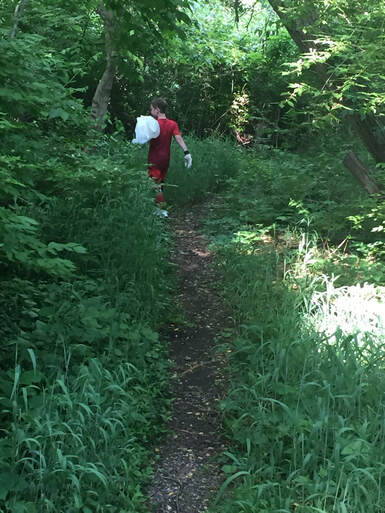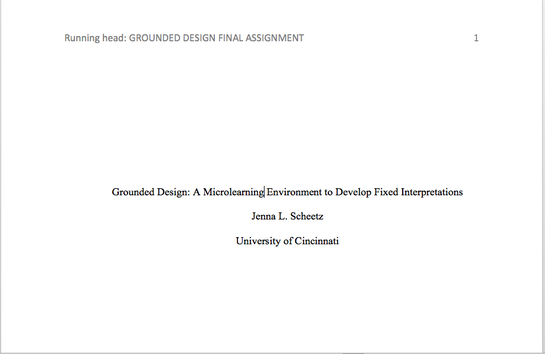Examples of my work in UC's IDT program
Micorolearning Project
REFLECTION:
This project was a proposal for a real-world training opportunity for sign language interpreters. The goal of this project was to use Grounded Design to create a proposed lesson for teaching a concept. The concept I chose to explore was if the automated messages of the relay service industry could be taught as fixed interpretations. In other words, taking the most common recorded messages of robocalls and scripting them in such a way that an interpreter would have to use minimal working memory to interpret the passage. Grounded Design meant I needed to pick a learning theory and an instructional theory that aligned. I chose Cognitive Information Processing as the learning theory, and Cognitive Load Theory as the instructional theory. Both have a focus on the limitations of working memory, which was exactly my focus. What I found most insightful about this project was the deliberate nature of alignment. This is development from the very beginning, and finding justification in a training with science to back it up. Instruction developed from this type of project is not about having an idea for an activity and then creating it and delivering it. It has substance, and research, and planning to set a strong foundation. This was transformative for me, as I thought of training as coming up with a cool activity and having a pretty graphic and then giving a multiple choice test at the end. This clearly showed me the depth of instruction.
I chose to include this project to highlight because it was the first course I took in my IDT program, and it had a big impact on me. It was fitting for my first course because it set the foundation for development for me. Grounded Design and alignment are vital to creating cohesive and comprehensive trainings. I wanted to highlight my ability to align teachings with theory and research.
This project was a proposal for a real-world training opportunity for sign language interpreters. The goal of this project was to use Grounded Design to create a proposed lesson for teaching a concept. The concept I chose to explore was if the automated messages of the relay service industry could be taught as fixed interpretations. In other words, taking the most common recorded messages of robocalls and scripting them in such a way that an interpreter would have to use minimal working memory to interpret the passage. Grounded Design meant I needed to pick a learning theory and an instructional theory that aligned. I chose Cognitive Information Processing as the learning theory, and Cognitive Load Theory as the instructional theory. Both have a focus on the limitations of working memory, which was exactly my focus. What I found most insightful about this project was the deliberate nature of alignment. This is development from the very beginning, and finding justification in a training with science to back it up. Instruction developed from this type of project is not about having an idea for an activity and then creating it and delivering it. It has substance, and research, and planning to set a strong foundation. This was transformative for me, as I thought of training as coming up with a cool activity and having a pretty graphic and then giving a multiple choice test at the end. This clearly showed me the depth of instruction.
I chose to include this project to highlight because it was the first course I took in my IDT program, and it had a big impact on me. It was fitting for my first course because it set the foundation for development for me. Grounded Design and alignment are vital to creating cohesive and comprehensive trainings. I wanted to highlight my ability to align teachings with theory and research.
| microlearning_vrs_setting.pdf |
Podcast Project
REFLECTION:
My field is sign language interpreting, so I would have never thought to make an audio podcast for a lesson. My lessons tend to be visually oriented. This particular assignment challenged students to create a lesson using Keller's ARCS model, specifically the
"A" for attention. I chose a topic that I teach in my current position, Visualization of the English Language for ASL Interpreting. Keeping the learner's attention throughout was done by adding in sound effects at just the right places, inviting the learner to engage in a breathing and visualization exercise, and finally asking the learner reflective questions. Keeping this at the 5-minute mark challenged me to only select the most relevant content that I thought would have the most impact. I work with Deaf people, so making a podcast, which is exclusively available only by sound, created some uncomfortable feelings. I provided a transcript so that the content is accessible to people who cannot hear.
I chose to highlight this project because it was a new concept for me. I wanted to show my ability to create a quality podcast for effective learning. My corporate employer doesn't use this type of learning environment due to the audience we serve. This was designed to be a supplemental learning tool. Before this course, I hadn't designed supplemental tools like this. I want to continue using this newfound skill.
My field is sign language interpreting, so I would have never thought to make an audio podcast for a lesson. My lessons tend to be visually oriented. This particular assignment challenged students to create a lesson using Keller's ARCS model, specifically the
"A" for attention. I chose a topic that I teach in my current position, Visualization of the English Language for ASL Interpreting. Keeping the learner's attention throughout was done by adding in sound effects at just the right places, inviting the learner to engage in a breathing and visualization exercise, and finally asking the learner reflective questions. Keeping this at the 5-minute mark challenged me to only select the most relevant content that I thought would have the most impact. I work with Deaf people, so making a podcast, which is exclusively available only by sound, created some uncomfortable feelings. I provided a transcript so that the content is accessible to people who cannot hear.
I chose to highlight this project because it was a new concept for me. I wanted to show my ability to create a quality podcast for effective learning. My corporate employer doesn't use this type of learning environment due to the audience we serve. This was designed to be a supplemental learning tool. Before this course, I hadn't designed supplemental tools like this. I want to continue using this newfound skill.
Multi-media Project-To Motivate
 Photo credit: Scheetz, 2018
Photo credit: Scheetz, 2018
REFLECTION:
This project had a goal of using multi-media to create a short, educational presentation using some type of multi-media. I chose to use video, photos, graphics, and music to deliver my presentation in hopes to motivate young people to take care of the environment around them. Children are not usually my audience as a corporate trainer, so this was a refreshing change, and a challenge. This project also challenged my video editing skills, as well as selecting the right songs, sound effects, visual effects, and photos to make the most impact. I chose to use young people as the characters in my video, since that was my audience. I also had to be mindful not to scare young people with doom or destruction of the earth, but to give them a sense of confidence that they could really make a difference despite their age. The sound effects and pictures I chose were informative and age appropriate. The action items had to be easy and accessible for young people to accomplish. I got input from my young actors on fun elements to add to keep attention (The "Floss Dance" and outtakes were some of the suggestions).
I chose to include this project in my portfolio because it was one of my favorites to create, share, and revisit. I believe it highlights my video editing skills, as well as my ability to use multi-media to deliver a successful lesson.

